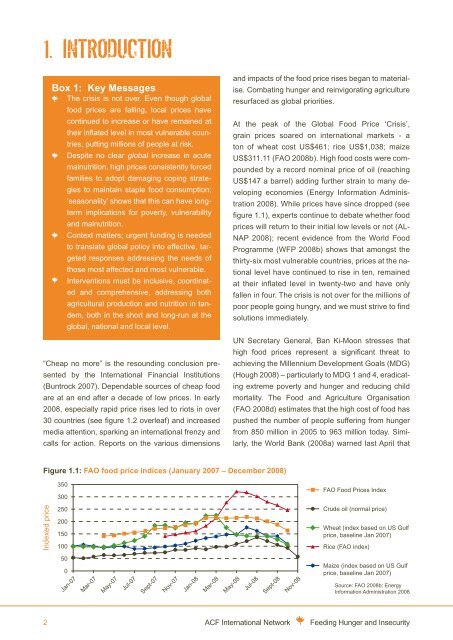Feeding hunger and insecurity
Feeding hunger and insecurity
Feeding hunger and insecurity
- No tags were found...
Create successful ePaper yourself
Turn your PDF publications into a flip-book with our unique Google optimized e-Paper software.
1. IntroductionBox 1: Key MessagesThe crisis is not over. Even though globalfood prices are falling, local prices havecontinued to increase or have remained attheir inflated level in most vulnerable countries,putting millions of people at risk.Despite no clear global increase in acutemalnutrition, high prices consistently forcedfamilies to adopt damaging coping strategiesto maintain staple food consumption;‘seasonality’ shows that this can have longtermimplications for poverty, vulnerability<strong>and</strong> malnutrition.Context matters; urgent funding is neededto translate global policy into effective, targetedresponses addressing the needs ofthose most affected <strong>and</strong> most vulnerable.Interventions must be inclusive, coordinated<strong>and</strong> comprehensive, addressing bothagricultural production <strong>and</strong> nutrition in t<strong>and</strong>em,both in the short <strong>and</strong> long-run at theglobal, national <strong>and</strong> local level.“Cheap no more” is the resounding conclusion presentedby the International Financial Institutions(Buntrock 2007). Dependable sources of cheap foodare at an end after a decade of low prices. In early2008, especially rapid price rises led to riots in over30 countries (see figure 1.2 overleaf) <strong>and</strong> increasedmedia attention, sparking an international frenzy <strong>and</strong>calls for action. Reports on the various dimensions<strong>and</strong> impacts of the food price rises began to materialise.Combating <strong>hunger</strong> <strong>and</strong> reinvigorating agricultureresurfaced as global priorities.At the peak of the Global Food Price ‘Crisis’,grain prices soared on international markets - aton of wheat cost US$461; rice US$1,038; maizeUS$311.11 (FAO 2008b). High food costs were compoundedby a record nominal price of oil (reachingUS$147 a barrel) adding further strain to many developingeconomies (Energy Information Administration2008). While prices have since dropped (seefigure 1.1), experts continue to debate whether foodprices will return to their initial low levels or not (AL-NAP 2008); recent evidence from the World FoodProgramme (WFP 2008b) shows that amongst thethirty-six most vulnerable countries, prices at the nationallevel have continued to rise in ten, remainedat their inflated level in twenty-two <strong>and</strong> have onlyfallen in four. The crisis is not over for the millions ofpoor people going hungry, <strong>and</strong> we must strive to findsolutions immediately.UN Secretary General, Ban Ki-Moon stresses thathigh food prices represent a significant threat toachieving the Millennium Development Goals (MDG)(Hough 2008) – particularly to MDG 1 <strong>and</strong> 4, eradicatingextreme poverty <strong>and</strong> <strong>hunger</strong> <strong>and</strong> reducing childmortality. The Food <strong>and</strong> Agriculture Organisation(FAO 2008d) estimates that the high cost of food haspushed the number of people suffering from <strong>hunger</strong>from 850 million in 2005 to 963 million today. Similarly,the World Bank (2008a) warned last April thatFigure 1.1: FAO food price indices (January 2007 – December 2008)350300FAO Food Prices IndexIndexed price250200150100Crude oil (normal price)Wheat (index based on US Gulfprice, baseline Jan 2007)Rice (FAO index)500Jan-07Mar-07May-07Jul-07Sept-07Nov-07Jan-08Mar-08May-08Jul-08Sept-08Nov-08Maize (index based on US Gulfprice, baseline Jan 2007)Source: FAO 2008b; EnergyInformation Administration 20082ACF International Network<strong>Feeding</strong> Hunger <strong>and</strong> Insecurity

















